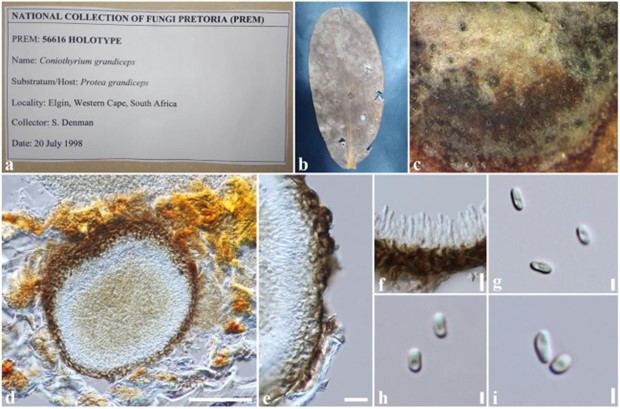Teichospora grandicipis (Joanne E. Taylor & Crous) Jaklitsch & Voglmayr, Mycol. Progr. 15(no. 31): 9 (2016). Fig. 153
≡ Coniothyrium grandicipis Joanne E. Taylor & Crous, in Crous et al. CBS Diversity Ser. (Utrecht) 2: 60 (2004).
MycoBank number: MB 815659; Index Fungorum number: IF 815659; Facesoffungi number: FoF 08368.
Saprobic on leaves of Protea grandiceps. Asexual morph: Conidiomata 230–260 mm (x̅ = 240 µm, n = 10) diam., immersed, dark brown to black, solitary, globose to sub-globose. Peridium 12–16 μm wide, 2–3 layers of light brown, textura prismatica cells. Conidiophores indistinct. Conidiogenous cells hyaline, cylindrical, slightly tapering towards apex and smooth walled. Alpha conidia 3.5–5.5 × 1.2–3 μm (x̅ = 4× 1.9 μm, n = 30), hyaline, one-celled, straight, fusiform to clavate with obtuse ends, biguttulate. Beta conidia not seen.
Material examined – South Africa, Western Cape Province, Elgin, on leaves of Protea grandiceps, 20 July 1998, J.E. Taylor & S. Denman, PREM 56616 (holotype).
Notes – Curreya grandicipis (Coniothyrium grandicipis) was introduced by Crous et al. (2011b) based on coniothyrium-like asexual morphs reported in species of Curreya. Later, Curreya grandicipis was synonymized under Neocurreya due to the doubtful phylogeny investigations (Thambugala et al. 2015b). However, Jaklitsch et al. (2016b) transferred Neocurreya grandicipis to Teichospora based on both morphological and phylogenetic results.

Figure 153 – Teichospora grandicipis (PREM 56616, holotype). a, b Herbarium. c Close up of conidiomata on host. d Sections through conidiomata. e Peridium. f Conidiogenous cells. g–i Conidia. Scale bars: d = 50 µm, e = 10 µm, f–i = 5 µm.
